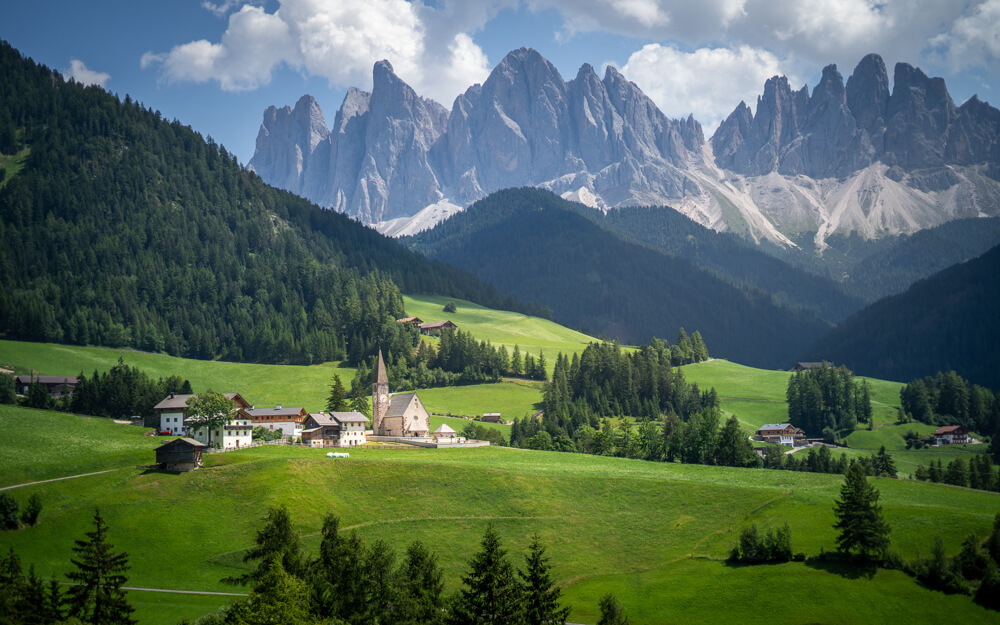The Italian Dolomites are a stunning mountain range with views that are right out of a postcard: jagged peaks, crystal-clear lakes, pine forests, and lush meadows with cute huts. It was without a doubt our favourite destination during our 3 weeks in Italy but also one of the toughest to plan. And yes, you need to plan your visit even if you’re not a planner because there are certain technicalities to taking Dolomites road trip: roads are closed for certain hours of the day, parking needs to be reserved beforehand, etc.
This 4-day Italian Dolomites itinerary takes you through the best spots that this UNESCO World Heritage Site has to offer: incredible hikes with breathtaking vistas, serene lakeside and meadow strolls, and charming alpine villages. The itinerary is perfect if you want to experience the best of the Dolomites in limited time. It includes the easiest ways to get to a place without hiking but does mention a few hikes that you simply cannot miss—after all, you’re in the mountains. But don’t worry, all the hikes mentioned are easy!
We visited the Dolomites in July, so this itinerary will focus on a summer road trip when there is no snow, all hiking trails are open, cable cars are functional and the days are long. That being said, it can be used for other seasons as well, except the winters.
Best Time to Go to the Dolomites
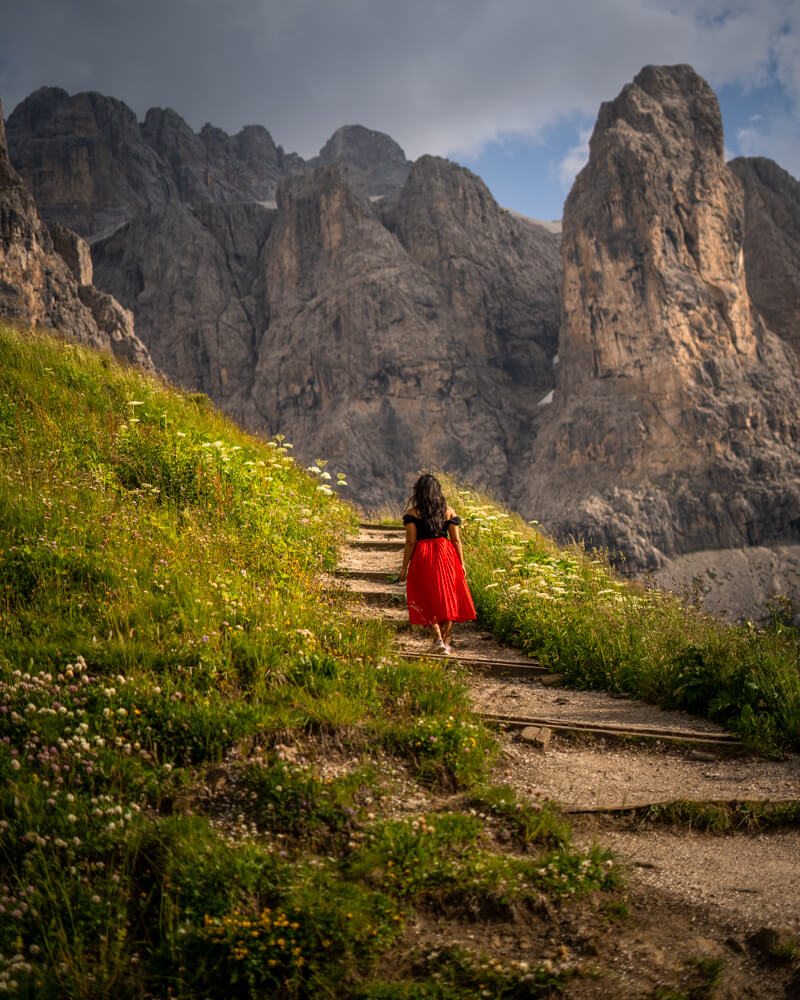
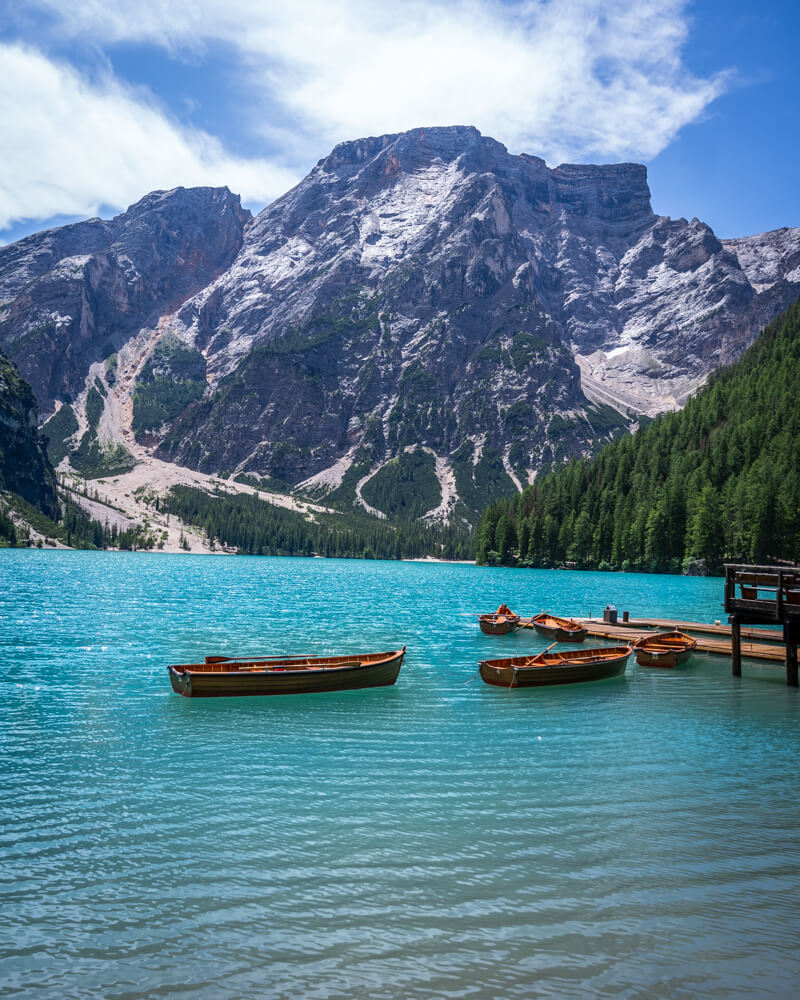
While we visited in the summer, the Dolomites can be visited year-round. Peak season is all year round except from November to early December (when it hasn’t snowed yet) and from April to the end of May (just before summer peak season)!
Spring (March to May): The snow melts and meadows come alive with blooming flowers. It’s a quiet time to visit before the summer crowds arrive.
Summer (June to August): This is the summer tourist season with the best weather for hiking and outdoor activities. The days are long, the meadows are green, the weather is mild and all the cable cars are functional. There were wildflowers all around when we visited the Dolomites in July as well! It was spectacular.
Fall (September to October): The crowds are less and the landscape has vibrant autumn colours. It’s still mostly a good time for hiking and great for photography. Though in October, it might start snowing, which may make some areas inaccessible, so it can be a bit of a gamble for hiking.
Winter (December to February): The Dolomites become a winter wonderland! Visit during this time only if you want to go skiing, snowboarding, or indulge in other winter sports.
The 4-day Dolomites itinerary given below can easily be followed from late June to late September, when the roads, rifugios, and cable cars are open. This is the best time to visit for hiking and enjoying the green meadows of the Dolomites without any snow.
Where to stay in the Dolomites in the summer?
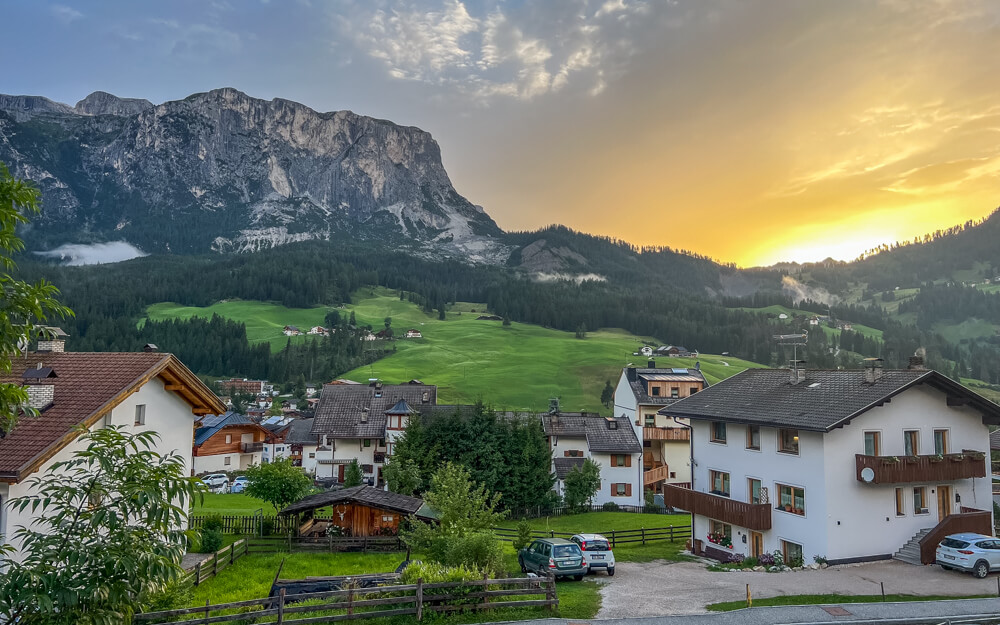
Most people divide their hotel stays, staying 2 nights in Ortesei (west Dolomites) and 2 nights in Cortina d’Ampezzo (east Dolomites). Both are stunning towns with perfect accessibility to the attractions mentioned in this itinerary and superb options for your stay as well. But remember that hotels in these towns are exorbitantly priced. Since, you have a car for this summer road trip in the Dolomites, you can easily stay 15-20 kilometres away as well.
However, we chose to stay in Alta Badia instead because we wanted to stay in one hotel for the entire duration of our time in the Dolomites. Plus, the hotel was significantly cheaper than the ones in the main towns mentioned above. Alta Badia is in the centre of the east and west Dolomites so it’s the perfect place to stay if you don’t want to move around a lot. However, it does increase your drive distance by 100 kilometres or so, considering the below mentioned Dolomites road trip itinerary.
Ortesei (or Urtijei):
Smart Hotel Saslong: Located 4 km from Ortsei with modern rooms, free parking, and breakfast that everyone raves about!
Hotel Ansitz Gamp: Located 18.4 km from Ortesei, this hotel has spacious rooms and a stunning outdoor pool.
Digart: Located 1.6 km from the centre of Ortesei, the apartment is perfect for a family.
Cortina d’ Ampezzo:
Hotel Regina: The rooms are small and basic, but the hotel is located in town so you’re close to everything but the parking is not free.
Hotel Villa Argentina: Located just 4.5 km from Cortina, this hotel has modern rooms with an in-house restaurant so you don’t need to drive to Cortina for dinner!
Hotel Al Larin: Located just a 5-minute drive from Cortina, this hotel has friendly staff and free parking!
Badia:
Ciasa Lisüra: Apartment on a budget with excellent views!
Hotel Ciasa Ai Pini: A cute hotel with spacious, well-appointed rooms, fantastic views, and a sauna!
Residence Ploner: A clean and comfortable apartment in the middle of a town!
Renting a Car for this Dolomites Road Trip Itinerary
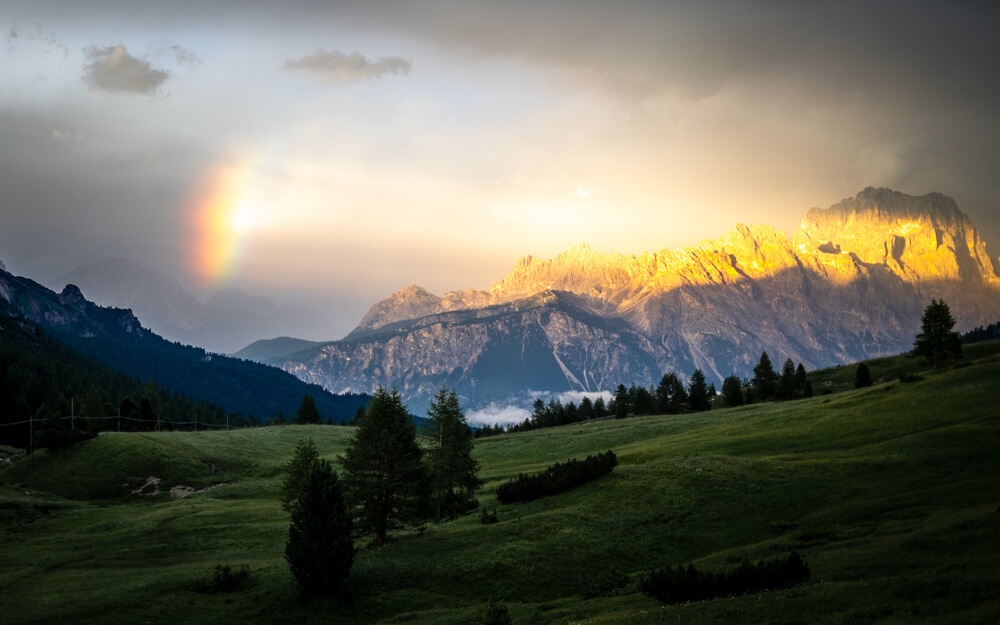
While it is possible to get around using a bus in the summer, you will have to work with the limited bus timings. This is a good option if you’re staying for longer or if you’re okay with missing some sights or not being able to stop whenever you like.
According to us, it is best to rent a car to get around in the Dolomites. You will have the utmost flexibility and will be able to hit all the spots on this itinerary.
Depending on where you’re coming from, you can rent a car in major cities like Milan, Venice, or Verona. We rented a car from Milan, visited Verona before heading to the Dolomites, and dropped it off at our next destination of our larger Italy itinerary, Venice. However, remember that you will incur a one-way fee for the rental car.
Within the Dolomites themselves, you can rent a car from Bolzano and return it in Cortina d’Ampezzo. To avoid a one-way fee, consider renting your car and returning it in the same town but this may end up wasting your time driving around.
In the Dolomites, you will be able to get by with a small hatchback. However, we wanted more comfort and ease of driving so we rented a small SUV and were very happy with it!
Check out cars on Rental Cars and book the best deal!
Tip: You will need an international driving permit (IDP) to rent a car in Italy if you’re not from the EU. We rented cars twice in Italy and were asked to produce an IDP each time. We got our IDP (soft copy) from the International Driver’s Association in 8 minutes, which was so convenient. The hard copy took a week to reach us.
4-Day Dolomites Italy Itinerary
Are you ready to be swept off your feet by the breathtaking beauty of the Dolomites! With these epic things to do in the Dolomites, you’re promised unforgettable moments and awe-inspiring vistas at every turn. So lace up those hiking boots, charge your camera, and take a road trip into this alpine wonderland.
Italian Dolomites Map for this Itinerary
This map has all the cities, attractions and parking lots mapped on it, so you can export them into your own Google Maps and visit them easily.
Day 1: Rent a car and visit Lago di Carezza
Rent your car and head to Lago di Carezza ( Lake Carezza or Karersee). It is a stunning alpine lake that has clear emerald waters with a backdrop of lush forests and towering mountains. On a still day, the reflections of this backdrop in the lake create a mesmerising scene.
After soaking in the beauty of the lake, head to your hotel near Badia or Ortesei (also called Urtijei). Spend the rest of the evening enjoying your hotel, resting, or walking around the town.
Ortesei has really wacky sculptures all around the town, which are quite fun to see, while Badia has incredible views.
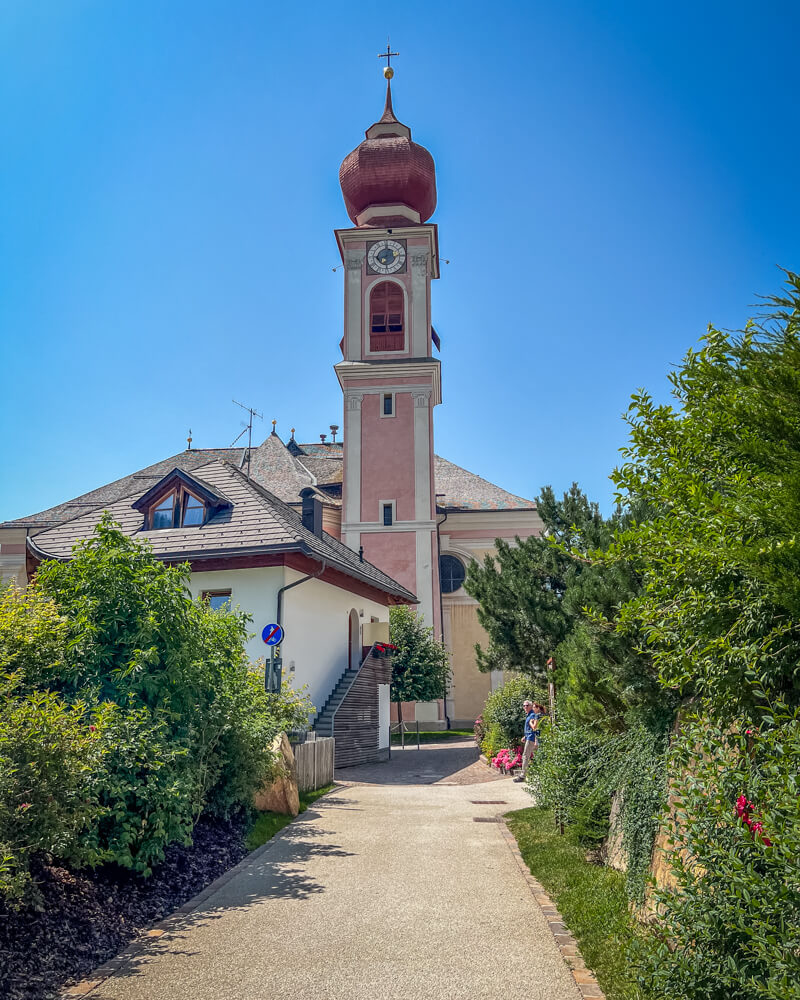
Day 2: Alpe di Siusi and Val di Funes
Today is the day to enjoy the serene alpine meadows with a gorgeous backdrop of the Dolomites.
Alpe di Siusi (Seiser Alm)
Start your morning early by visiting Alpe di Siusi. Also known as Seiser Alm, this is Europe’s largest high-altitude Alpine meadow. The area is best visited during the spring and summer months, when the meadows are green and there are windflowers all around.
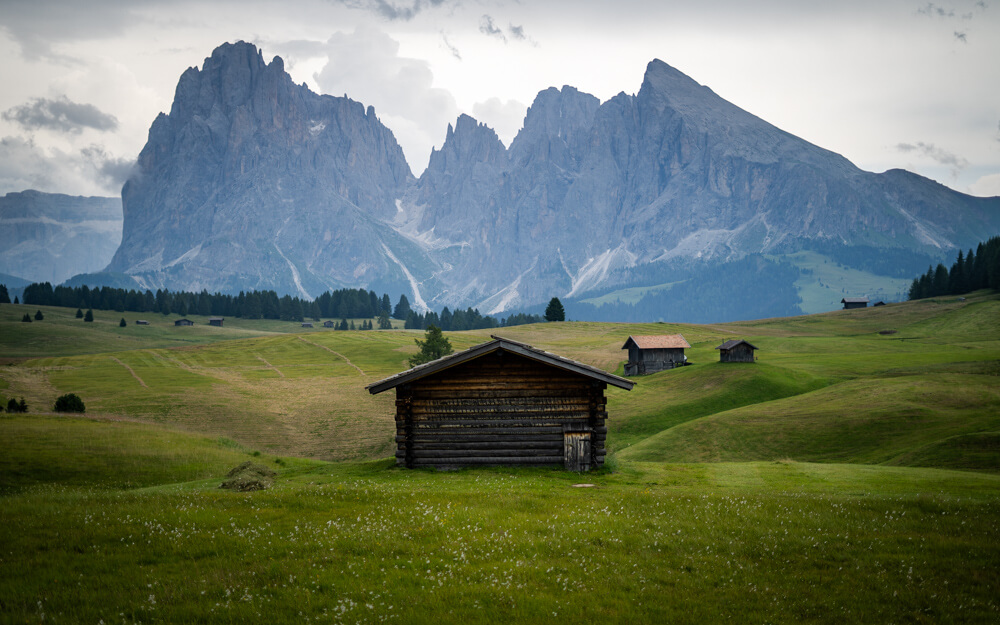
Alpe di Siusi by Gondola (best if you don’t want to hike)
Take the Mont Seuc Cable Car from Ortesei to Alpe di Siusi, which starts at 9 a.m. Instead of buying separate tickets for the cable car to the top and the chairlift to Hotel Sole / Sporthotel Sonne, I highly advise getting a combined ticket that includes both to get the best bang for your buck. Check timings and updated prices here.
Once you get to the meadows, head towards Malga Sanon (or Sanon Hut), a mountain hut that serves the best apple strudel we have EVER HAD. It’s a 35-minutes walk from the gondola, and if you take the chairlift down to the hotel Sole, then from there it takes 15 minutes by foot.
On the way, stop to admire the breathtaking scenery and photograph the rolling hills and jagged mountains. There is no rush, take it slow and enjoy the meadows. There is no place quite like it, and we cannot wait to return and spend a night in Alpe di Siusi!
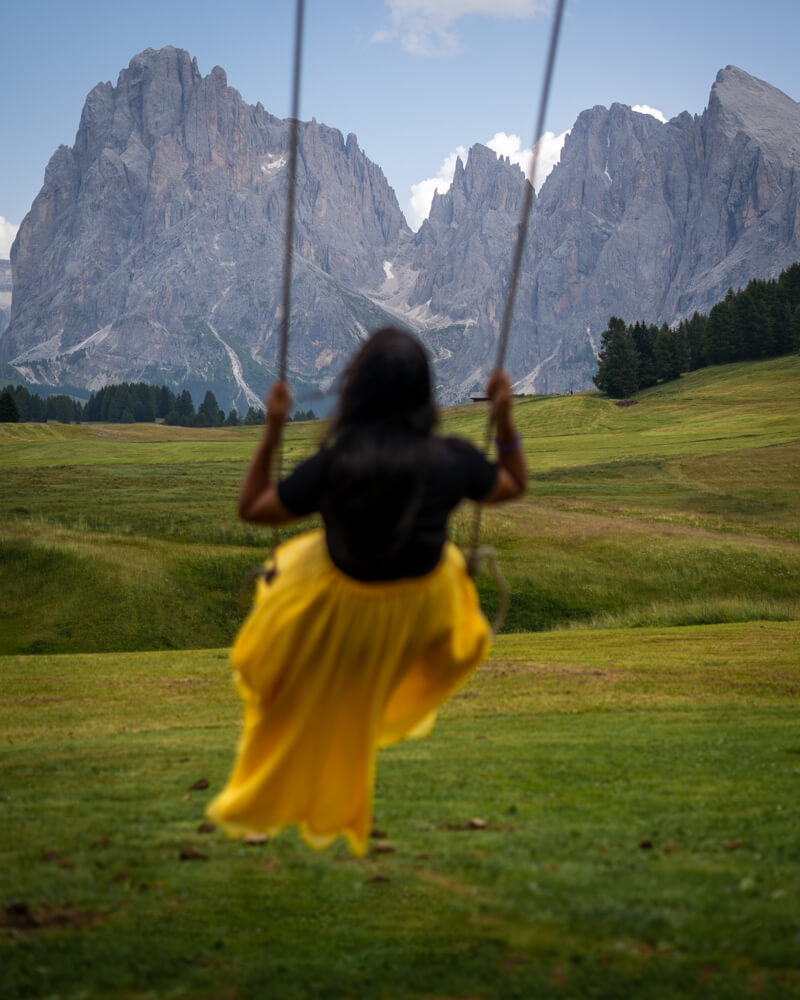
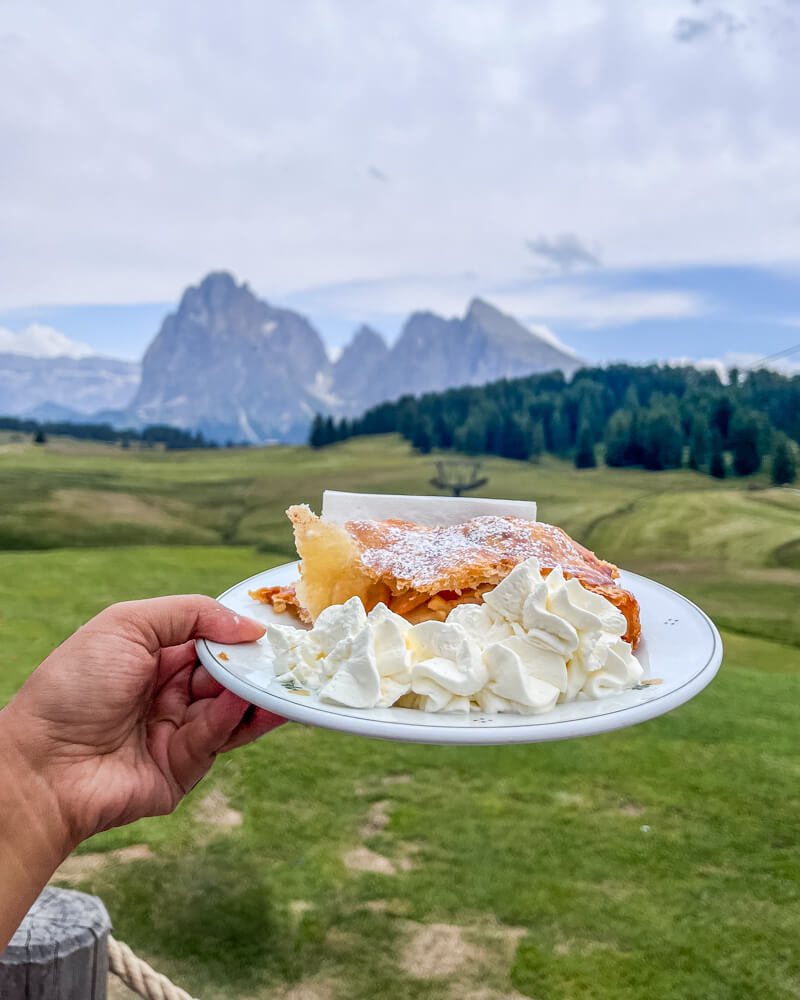
Alpe di Siusi by Car (Best for photographers and hikers)
But if you’d like to see Alpe di Siusi at its most mysterious, shrouded in mist, then I recommend you get there around sunrise. Since you can’t use the Gondola at this time, you will have to drive up to a parking lot at Parking Place Spitzbühl P1 at Compatsch, which is free. There is another parking lot, Compatsch P2, which has a charge of €26.50. Either way, allow yourself about an hour to walk to Malga Sanon.
Note that you aren’t allowed to drive up this road between 9 AM and 5 PM since it is a private road. So make sure you’re at the parking lot much earlier than this. You can drive back down anytime you like.
Val di Funes
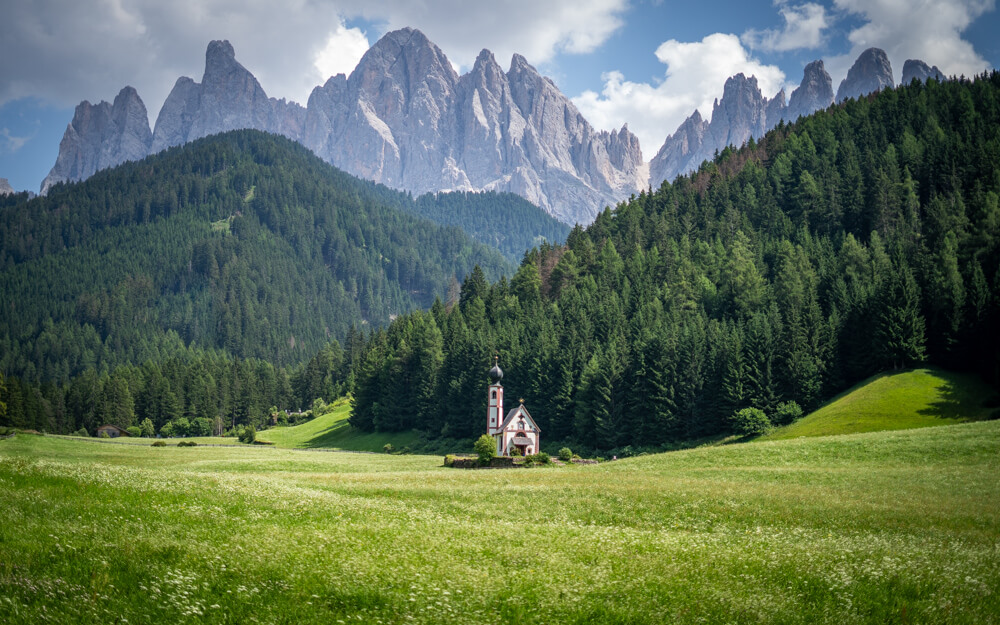
Start by visiting St. John Church, a small church that is one of the most photographed churches in the region. And you can’t blame the photographers; the church makes the perfect subject. It has an idyllic setting complete with meadows, forests, and rugged peaks towering in the background. You can stop at the viewpoint to photograph the church or you can even visit it.
You can easily park your car at the parking spot nearby, Parkplatz Parcheggio (Google Maps location).
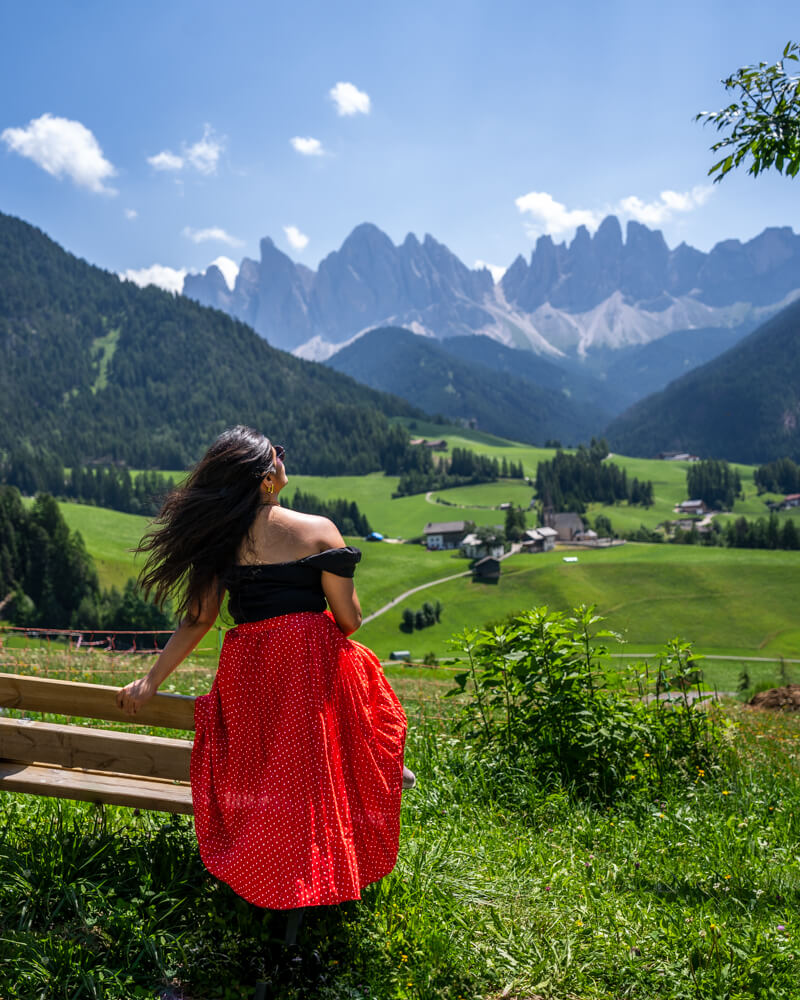
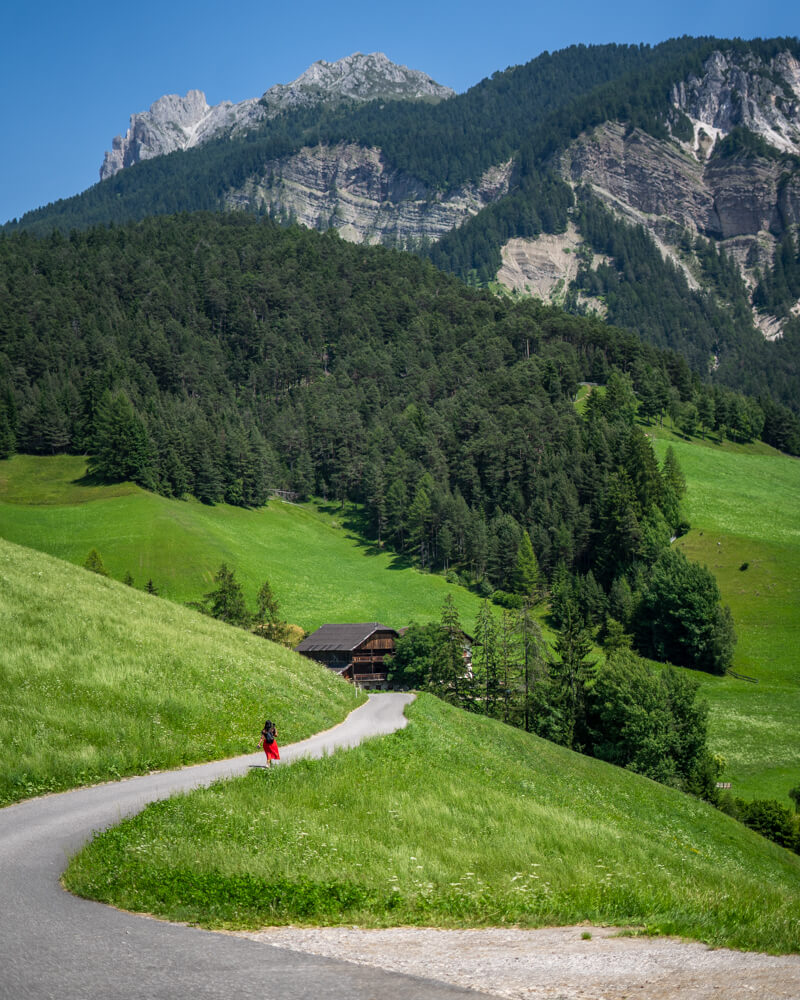
Then make your way to the tiny village of Santa Maddalena, again known for its quaint church set against the backdrop of the Odle Mountains.
Park your car at either Parkplatz Bergerplatz or the St. Maddalena parking lot. Then walk through the village until you reach a beautiful trail surrounded by meadows. Keep walking up the gradual incline to Santa Magdalena Viewpoint and then to Panorama di Santa Maddalena. The views are absolutely mind-blowing!
And if you get here around sunset (which hopefully you will), you’ll see the sun cast an orange hue on the Odle Mountain Range. Be prepared for your jaw to drop!
However, do remember that this particular viewpoint is quite famous so you might find quite a few other people around.
Day 3: Seceda and Passo Gardena
If you’re changing hotels this day, check out and take all your luggage with you in the car.
Seceda Ridgeline
Easily our second favourite place in the Dolomites, Seceda, with its unique jagged peaks and steep cliffs, is a sight to behold. The area also provides stunning panoramic views of the Odle mountain range you saw the previous day, the Val Gardena valley you’ll see closely next, and the other surrounding Dolomite peaks.
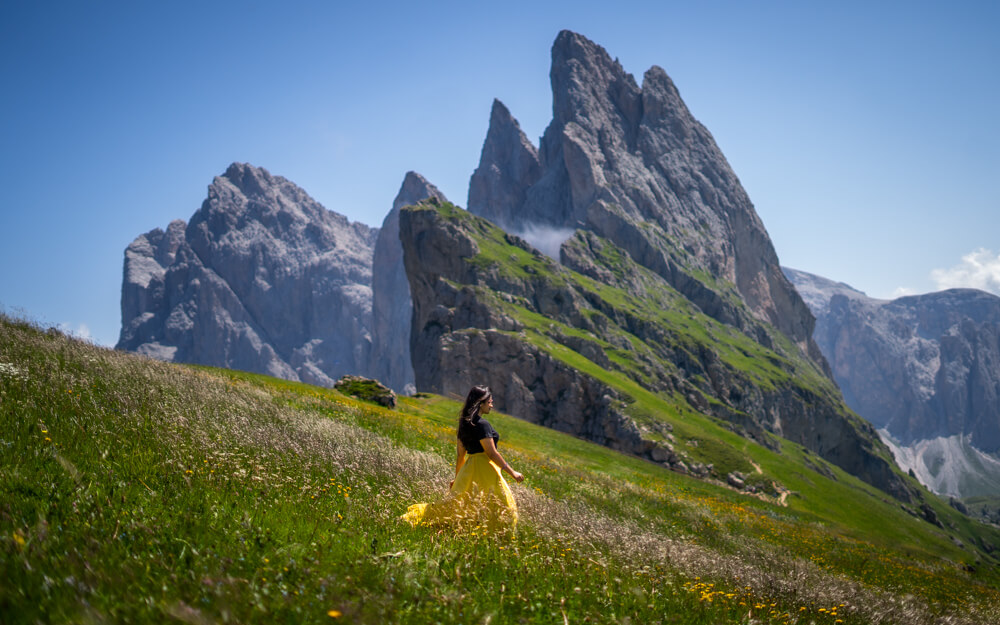
To get here, park your car in Ortesei at the Seceda cable car parking lot. It is a huge parking lot but it can obviously get full during the summer. As usual, I would recommend getting to the cable car station as soon as it opens.
There are a few ways to get to Seceda. You can hike the whole way up if you’re an avid hiker, take the cable car to the halfway point and hike the rest, or take the cable car all the way to the top. A lot of people choose to take a one-way ticket to the top and hike all the way back down.
You can easily kill a couple of hours here because the area is so beautiful. And if you’re famished, have lunch at the restaurant in Seceda. The food is not bad and the views are fantastic.
Passo Gardena
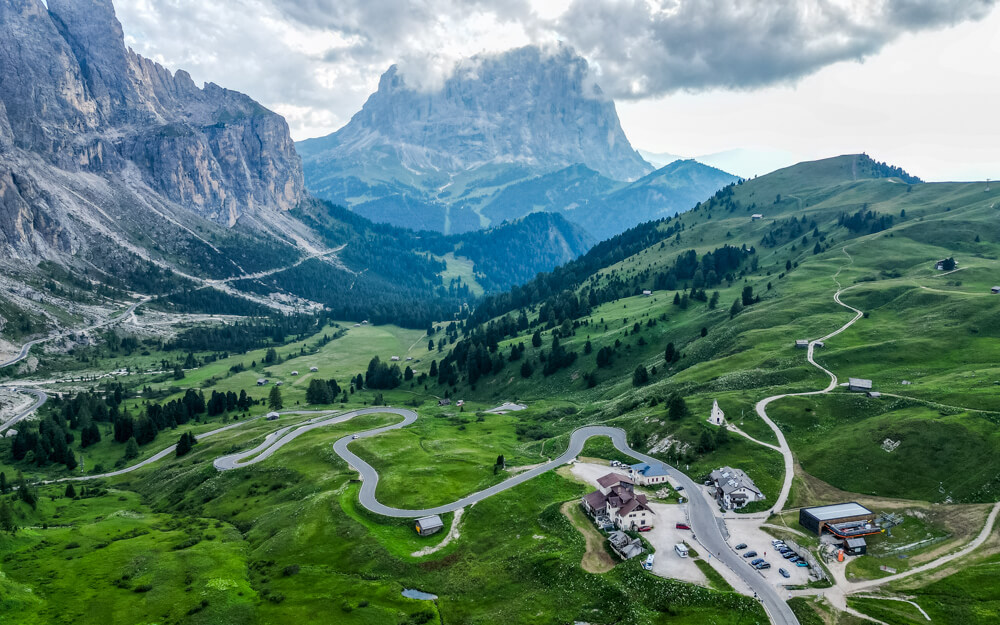
Make your way to Passo Gardena, a mountain pass renowned for its breathtaking scenery and panoramic views in every direction. The drive through this pass is probably the most beautiful in all of the Dolomites.
You can park your car at the parking lot of Rifugio Frara and walk around one or more of the many trails around. We spent a few hours here admiring the views and ended up having dinner at Rigugio Frara itself. One of my most memorable meals from Italy. The food was good and the views were even better.
Another good alternative is Rifugio Jimmi, close by.
Cortina d’Ampezzo
If you are switching hotels and staying close to Cortina d’Ampezzo, then visit the town today!
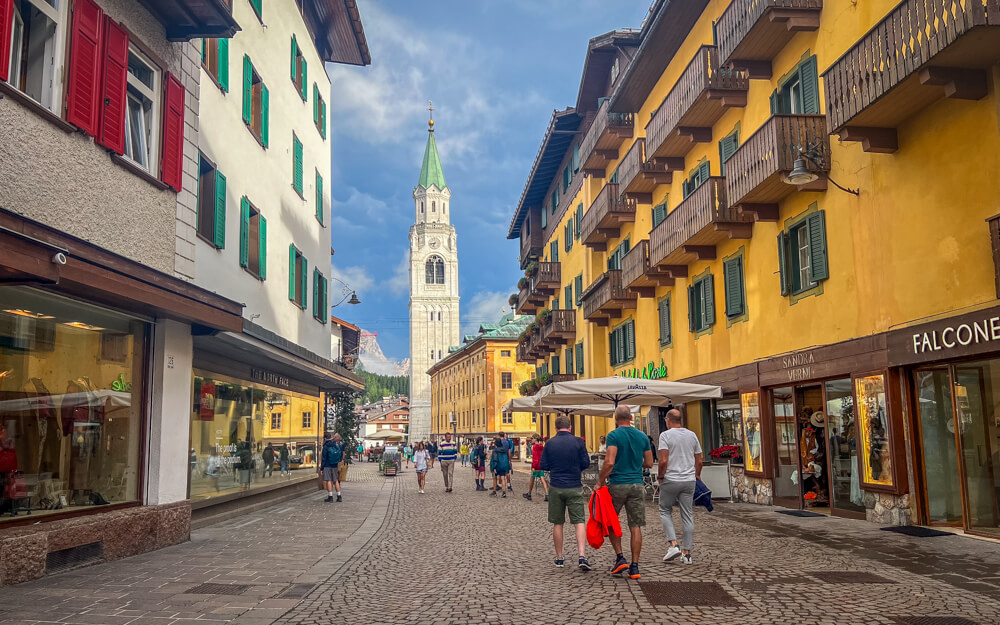
Cortina d’Ampezzo is a picturesque town surrounded by towering mountains and is a rather popular town due to its proximity to the best sights in the eastern Dolomites. Cortina is great for hikers and mountain bikers, as well as for cultural enthusiasts with its museums and historical sights.
Day 4: Tre Cime di Lavaredo, Cadini di Misurina, and Lago di Braies
Your final day in the Dolomites is going to be another day with jaw-dropping scenery and quite a bit of hiking. You’ll start by heading to the parking lot located next to Rifugio Auronzo, from where two famous day hikes start: Tre Cime di Lavaredo and Cadini di Misurina.
This is a large parking lot but it can get completely full by 9 to 10 am during the summer (much like Seceda). Not only that, because of its popularity, there is a limit to the number of vehicles that can drive up this road in the summer months.
Just after Lago d’Antorno, there will be a toll booth where you will have to pay €30 (check updated prices and road conditions here) to drive a car to and park in the Tre Cime parking lot. You will only be allowed to drive up to it if there are parking spaces available so its best to get here early! If you arrive after 10 AM, you will most likely have to wait in line at the toll booth. Only when a car exits will another be allowed to go up so the wait could be long.
Cadina di Misurina
Start with Cadini di Misurina because this hike is Instagram famous and with good reason: the view from here is sensational and very different from all others in the Dolomites.
The hike is an easy 3.2 km loop! To get here, take a right from the parking lot and follow trail 117 in the direction of Rifugio Col De Varda towards the Cadini di Misurina viewpoint—a long outcrop and narrow rock with a thin trail. This is where you get the famous view pictured above. Drone shots are absolutely divine here.
Beware though, it is a narrow trail and spot with lots of big tree roots, increasing the chances of a possible fall. It is best to avoid this hike if it is or has been raining and the trail is wet and slippery.
And well, this is why we couldn’t do the hike ourselves. It was raining cats and dogs and we didn’t want to risk it. So with much disappointment, we completely skipped both hikes on this day and can’t wait to return to the Dolomites to see what we missed.
Once you are done, retrace your steps back to the parking lot for the next hike.
Tre Cime di Lavaredo
After completing the Cadini di Misurina loop, head to Tre Cime di Lavaredo, three distinctive mountain pillars (or peaks) that are part of the Sesto Dolomites and are surrounded by a number of other impressive mountains like Cadini di Misurina! You might look at photos and think, ‘hey, this looks skippable’, but you really shouldn’t. These three peaks are the symbol of the UNESCO World Heritage Site, which is the Dolomites. They are one of the most photographed mountains in the world and are much loved by everyone visiting the Dolomites for a reason.
While there are several trails in the area, go for the Tre Cime di Lavaredo Loop Trail, an approximately 10-kilometre loop that takes you around the base of the three peaks and offers breathtaking views of the surrounding mountains. The trail is easy-moderate and can be completed in 3.5–5 hours, depending on your speed! It is not a difficult hike so you should be able to do it easily as long as you don’t have reasonable fitness.
Lago di Braies
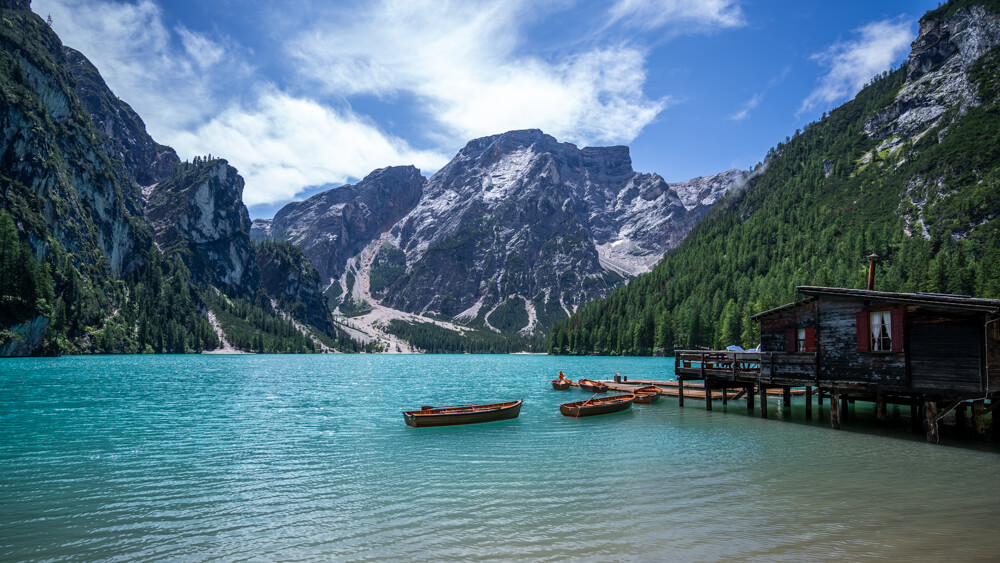
Lago di Braies is perhaps the most popular lake in the Dolomites and you’ve probably seen it all over Instagram. Also known as Pragser Wildsee, it is a picturesque alpine lake with turquoise waters surrounded by soaring grey mountains and lush spruce pine forests. It’s an incredibly soothing sight but in my opinion, it is more beautiful in photos than in reality.
But that in no way means you shouldn’t visit because the lake is definitely more than just a photo op. The best thing to do here is to walk the loop around the lake (a must), chill at the stony beaches, and slowly row a rental rowboat on the lake.
However, visiting Lake Braies has a few complexities in the summer months that you need to be aware of. We were so confused before we went, but it all turned out to be very simple.
Between 9 am and 4 pm between July 10 and September 10, 2024, you can only drive through the Pragser Tal Valley and park at Lago di Braies with the presentation of an online reservation for a parking lot, which you can easily book here closer to your date of travel. P4 is the closest parking lot, P3 is close by (we parked here), and P2 is about a 1-kilometre walk to the lake. P1 is very far off!
Tip: If you’d like to see the lake without a lot of people and grab the typical photos of the boathouse and parked boats, then I suggest you get here super early (just after sunrise) either this morning before heading for the hikes or, better yet, the next morning before returning your car.
Even though we got there at noon, we were able to snap a few quick photos of the parked boats because it had just rained heavily and no one was out on the lake already. But that also meant that the water was not still and we couldn’t capture the reflection of the mountains on the lake.
Tips & Must-knows
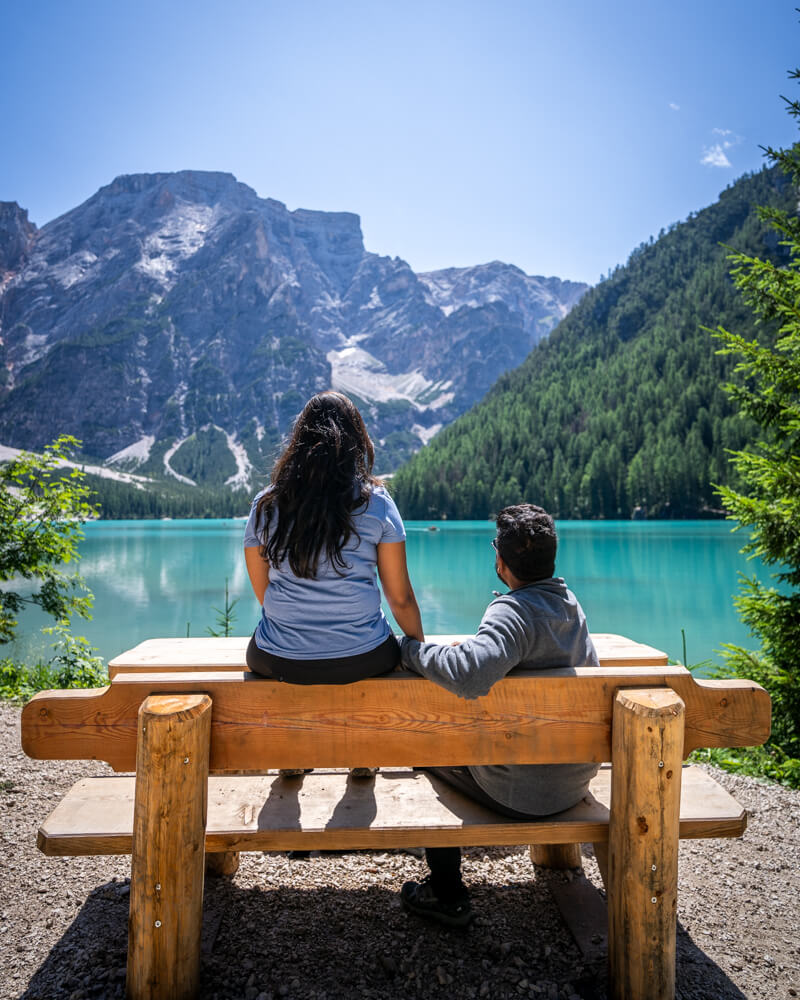
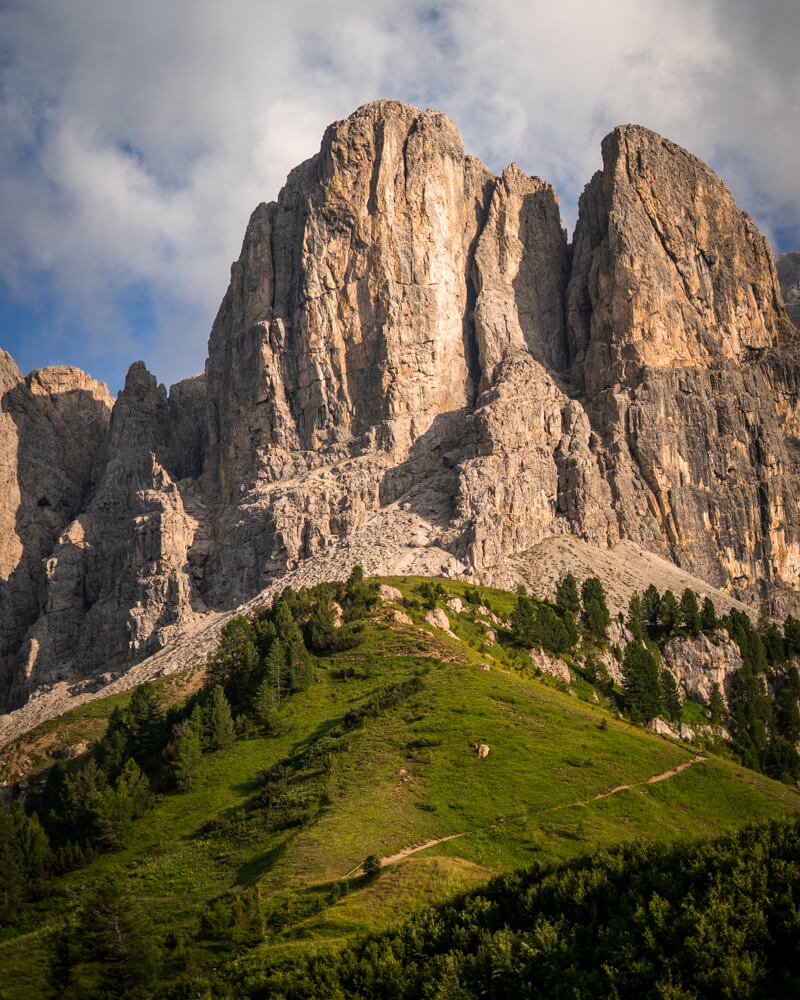
- When visiting the Dolomites in the summer, you will need to wake up early to get a parking spot at famous sites like Tre Cime di Lavaredo, Seceda and Siesler Alm
- Book your trip at least 4-5 months in advance because hotels can be tough to find at a reasonable cost.
- Check weather updates even in the summer months. We were caught in a storm twice, even though it was bright and sunny just an hour or so before.
- Carry a light sweater, rain jacket, and hiking shoes.
- The languages spoken are Italian and German. Yes, german. You will also notice that most places in the Dolomites have two names, one in both languages. So the town of Ortesei is also called Urtejei.
- Carry cash. The Internet can be spotty in some places so not everyone accepts credit cards or an extra charge is levied for credit card transactions.
Other Reads from Italy
Italy in 10 days: An Itinerary for Your First Visit
3 Days in Rome Itinerary
2-Day Florence Itinerary
How to visit Saturnia Hot Springs in Tuscany
How to see all 5 villages of Cinque Terre in one day
A Complete Guide on Going for a Day Trip to Lake Como from Milan
This blog post on ‘Perfect Dolomites Itinerary’ has affiliate links that enable us to earn a small commission when you make a purchase, with no extra cost to you. We only recommend products and activities we like and those that might interest you. If you like any suggested product, do buy from the given links.

